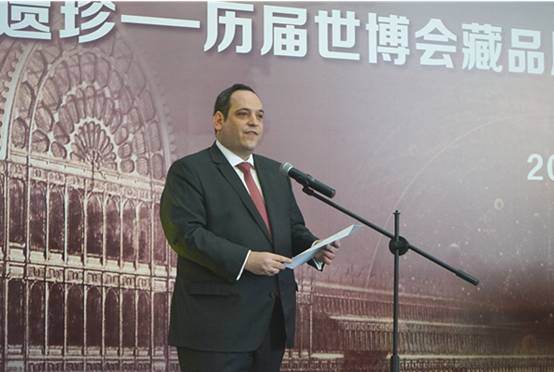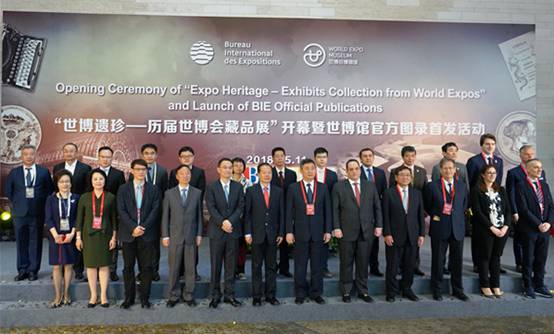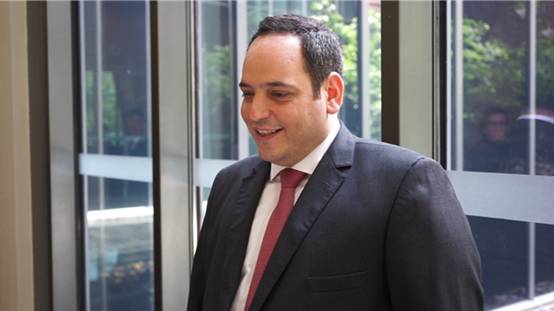"Xiao Di" of the International Bureau of Exhibitions: Expo 2010 Showcased an Open China
日期:07-06-2018来源:eastday.comIn the Puxi section of the Expo 2010 site, there sits the World Expo Museum where flags of nations wave to guests from around the world. Eight years have passed since the opening of Expo 2010, but the image of Expo have never faded from this city.
On May 11, visitors from candidate host countries of Expo2025 - Kazakhstan, Japan, Russia - gathered at the World Expo Museum to witness the opening of the exhibition “Expo Heritage: Exhibits Collections from World Expos” and the launch of the Official Album of World Expos.“This marks a new stage for World Expo Museum. As we can see, it has become a global cultural landmark and a showcase of World Expos,” said Dimitri Kerkentzes, Deputy Secretary-General of the International Bureau of Exhibitions (the BIE).

Dimitri, Deputy Secretary-General of the BIE, spoke at the opening ceremony of the exhibition “Expo Heritage: Exhibits Collections from World Expos” and the launch of the Official Album of World Expos.

Chinese and foreign guests attending the ceremony
Dimitri is an old friend of Expo 2010 and Shanghai. DuringExpo 2010, he spent seven months in Shanghai as a representative of the BIE. People here affectionately called him "Xiao Di". Today, the World Expo Museum recalled the scene eight years ago.

Dimitri was interviewed by Eastday.com at the World Expo Museum
Expo 2010 Shanghai showcased an open China
Many people believe that Expo 2010 was a Chinese dream coming true. As early as in 1851, China participated in the first World Expo in London, England. A Chinese merchant Xu Rongcun brought his silk products to the Expo. He was the first Chinese to have participated in a World Expo. However, China's dream of organizing a World Expo had not come true until the early 21st century after a long journey of reform and opening up. To some extent, Expo 2010 was a "witness" of China's commitment to opening up to the outside world. In return, the Expo became a powerful magnet that attracted people from all over the world.
“Expo2010 showcased an open China to the world,” Dimitri said.“During Expo 2010, 190 countries gathered in Shanghai. They did not only spent six months here, but had built their pavilions a year before. In other words, two years before Expo 2010 opened, Shanghai had already gathered people from all over the world and used this as an opportunity to showcase China commitments and achievements to the world. This was the cornerstone of the success of Expo2010: the participants really felt the welcome from Shanghai and felt very much at home. The success of Expo 2010 was a natural outcome.”
China Pavilion is one of the largest pavilions in the Expo park and its China Red indicates the pride of China. The pavilion reviewed the progress of urbanization in China over the past 30 years."I still remember that at 6 o'clock every morning, a huge crowd of visitors would queue up to enter China Pavilion." Speaking of China Pavilion, Dimitri is still very impressed.“I was moved to see the Chinese visitors love their national pavilion so much. The foreign visitors were also amazed by the China Pavilion. They enjoyed the Chinese culture and everything that the country showed in the pavilion.”
In Dimitri's view, Expo 2010 is unique. Shanghai has set multiple records of World Expos: the largestnumber of participants, the largesttotalnumber of visitors, and the largest number of visitors on a certain day. Another key point is that it was the first World Expo ever that had been held in a developing country. China had not only organized the event, but also showed its enthusiasm and hospitality to the world. Expo 2010 highlights China's influence and proves that China is willing to work with other countries to create a safer future for mankind.
Most of all, China finally realized its dream of hosting a World Expo. From the opening ceremony on May 1, 2010 to the closing on October 31, Dimitri had stayed with Expo 2010 and witnessed the unremitting efforts of thousands of Expo Dream Builders."Nothing is perfect in the world, but I was really impressed by what I saw every day. The organizers had worked so hard to solve any problems, however trivial, that have been reported. Every day for six months. Expo 2010 had improved day by day. That gave me a very deep impression. They were not satisfied with the status quo; they were committed to excellence. To some extent, this reflects the core value of World Expos.”
From opening door to building partnerships, the city of Expo set a great example
Expo 2010 has left China and the world with more than just good memories. Its spiritual legacy still continues. According to Dimitri, no one can deny the success of Expo 2010, not only because it has set records, but also becaust it has left valuable legacies. He believed that Expo 2010 has left two major legacies: one is the World Cities Day established by the United Nations, and the other is the World Expo Museum.
The World Cities Day echoes the theme of Expo 2010 -"Better City, Better Life". Dimitri said:"Expo 2010 has played a significant role in promoting sustainable urban development. During the six months, the Expo allowed us to share the experience of China and the world, and put our heads together to evaluate similar sustainability issues. Therefore, the Chinese government decided to continue this spirit and proposed to the United Nations at Expo 2010 Shanghai Summit Forum to establish a special day dedicated to creating sustainable cities. That was a great moment and also reflected the global influence of Expo 2010.”
If China's reform and opening up program has opened the door of Shanghai, then Expo 2010 promoted Shanghai's partnerships with the outside world. Expo 2010 has helped Shanghai to complete a successful transformation, and Shanghai is now contributing more wisdom to the world. As a long-term project between the Shanghai Municipal Government and the BIE, the World Expo Museum follows theBIE'score values:“Education, Innovation and Cooperation”, and becomes a knowledge base of the Expo culture and innovations, providing a platform for cultural exchanges related to World Expos.
“Any museum is first of all responsible for promoting public education.” Dimitri believes that the World Expo Museum needs to play a greater role in public education. He said that in the next few months, the BIE would work with the World Expo Museum to render the museum a platform for education, not only in Shanghai, China, but also as a global education platform.
Since it opened, the museum has made its presence atExpo2012 Yeosu, Expo2015 Milan and Expo2017 Astana. AtExpo2020 Dubai, the world will see it again. Dimitri said:"The BIE expects that the World Expo Museum will participate in discussions with experts from around the world at the forum in Dubai. We also hope that the World Expo Museum will benefit from sharing thoughts, and bring the benefit back to Shanghai and play a greater role in future World Expos.”
During China's reform and opening up, Shanghai has undergone many changes. It would take on a new look within just a couple of years. But Dimitri said with deep affection:"The feeling the city gives me has never changed. It is the same as it was when I first came in 2006. It is always enjoyable walking in any corner of the city. Shanghai is a multi-cultural city. It is an international city. I won't get tired of it no mater how many times I've come here.”
(translation: Expo museum)